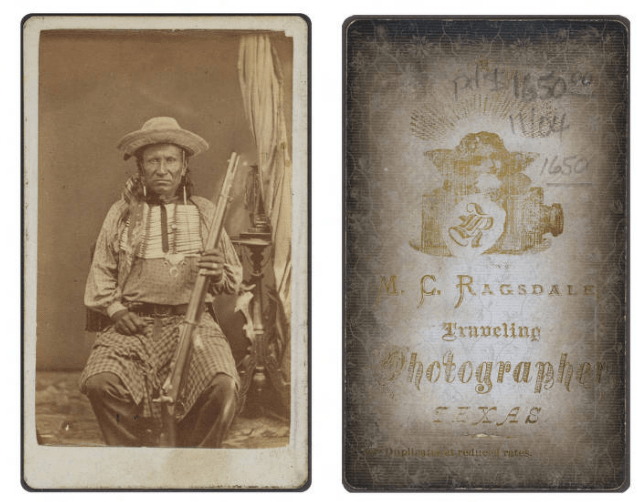
For those of us who are local history junkies, much of the evidence that backs stories of the older days is found in sometimes blurry, hard to decipher black and white photographs. These old photos document the original locations of buildings, ranches and home sites, and provide a visual record of family members long gone.
It’s easy today to snap a photo of just about anything, since most people are armed with a cell phone, but in the early days the photographing of historic structures and a town’s growth, or lack of it, was a much more complicated business. Heavy equipment and the time-consuming process of development meant that most old photos of our area, at least from the 19th century, were probably taken by a handful of people. One of these people was traveling photographer McArthur C.Ragsdale. If you have a photo taken in Brown County between 1870 and 1880, there’s a decent chance it was taken by Mr. Ragsdale.
“Old-Timers will find in their family albums many portraits bearing the name ‘Ragsdale” in the lower right hand corner of the card,” reads an article in an April 1938 edition of The Brownwood Bulletin. “Having pioneered the way, Ragsdale was followed here by two brothers, Dr. F. C. Ragsdale and M. E. Ragsdale, and by a sister, Mrs. Fannie Canon, who still live here. There are two other brothers, one living in Dallas and one in Nashville. The family originated in South Carolina, and it was a happy day for Texas when they decided to move to the Lone Star State.”
Ragsdale was termed an ‘“itinerant photographist” by one publication, a very descriptive and interesting phrase. During the post Civil War era in West Texas, according to an old photo advertisement of Ragsdale’s in the possession of the library at Southern Methodist University, he had a studio in Brownwood, possibly sometime in the late 1800s. Sadly, no address for the studio is recorded. “M.C. Ragsdale made San Angelo his headquarters but continued to make his rounds once every two years. His itinerary included Brownwood, Fort McKavett, and Junction among other places,” according to the book Tom Greene County Chronicles of Our Heritage, compiled by members of the Tom Greene Historical Preservation League. In a May 1894 note in the Brownwood Bulletin, it was recorded that Ragsdale visited relatives in Brownwood for revival services, and stated that he was once a resident of Brownwood sometime in the late 1870s.
Ragsdale used his knowledge of photography, and the cumbersome equipment needed to produce it, to document much of the early history of San Angelo. He was employed by Fort McKavett to take photographs there as part of their inventory keeping process. Most of his work, however, seems to have been portraits of local families and landscapes. Unlike most early photographers, Ragsdale occasionally photographed subjects that were humorous, such as his little boy making faces and a portrait of a toad on a rock.
I could not find an old photo from the Brownwood area that had Ragsdale’s signature on it, but that doesn’t mean there isn’t one. The Texas State Historical Association says that there is a collection of around 2,500 of his photos, called the M. C. Ragsdale Photograph Collection, at the Fort Concho Museum. “The collection consists primarily of his later photographs, although rare photographs of San Angelo in the 1880s and the Ben Ficklin flood are included. Ragsdale died on September 14, 1944”.
Photographers don’t usually get elevated as formative to our historical records as much as chroniclers or important figures in the development of a town, but without their contributions we would know a lot less about local history. Although some of Ragsdale’s photos were destroyed when he sold his San Angelo studio and the new buyer disposed of many of his negatives, it’s entirely possible that more than one person in Brownwood might have a photo taken by him and not know it.
***
Diane Adams is a local journalist whose columns appear Thursdays on BrownwoodNews.com
